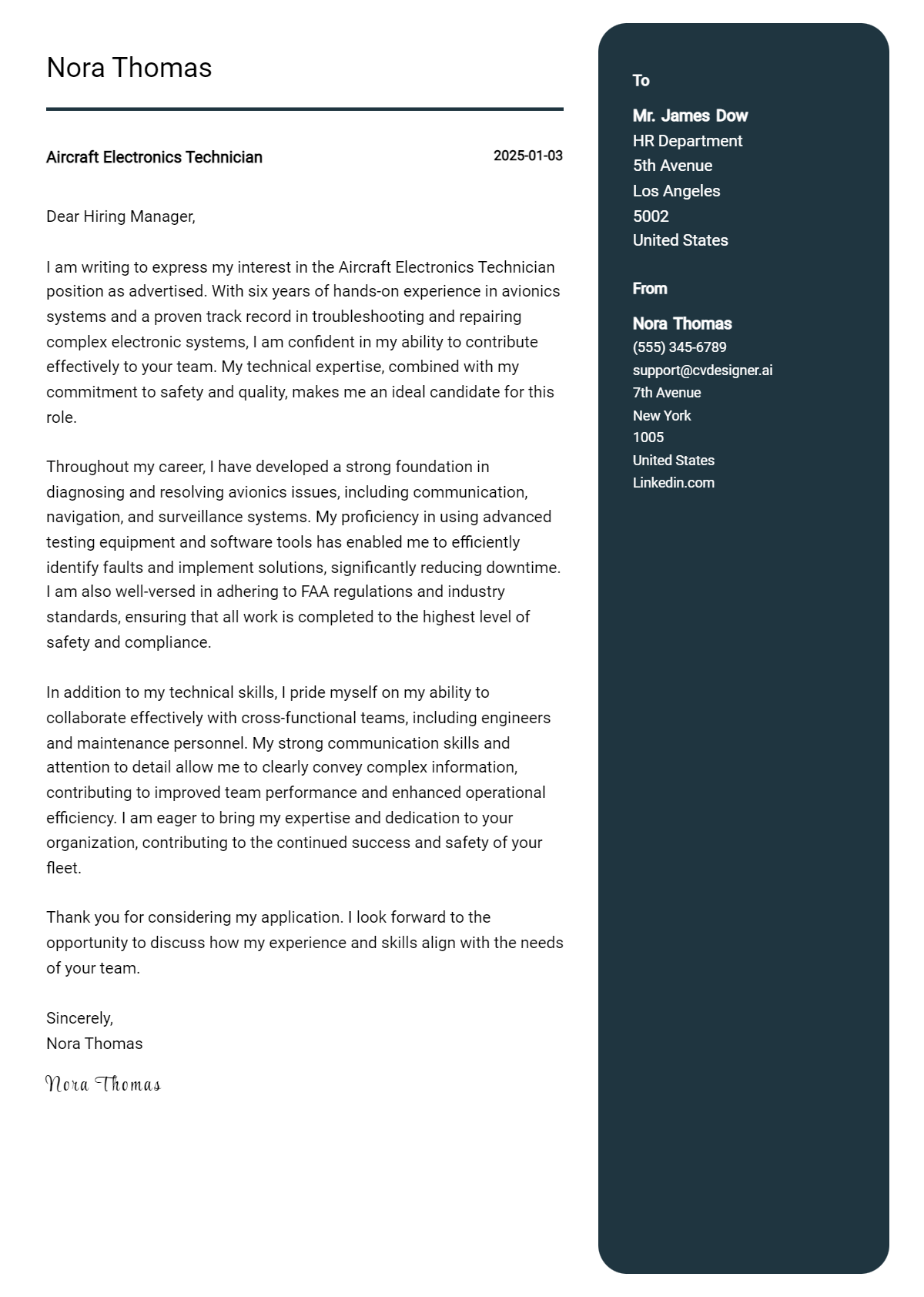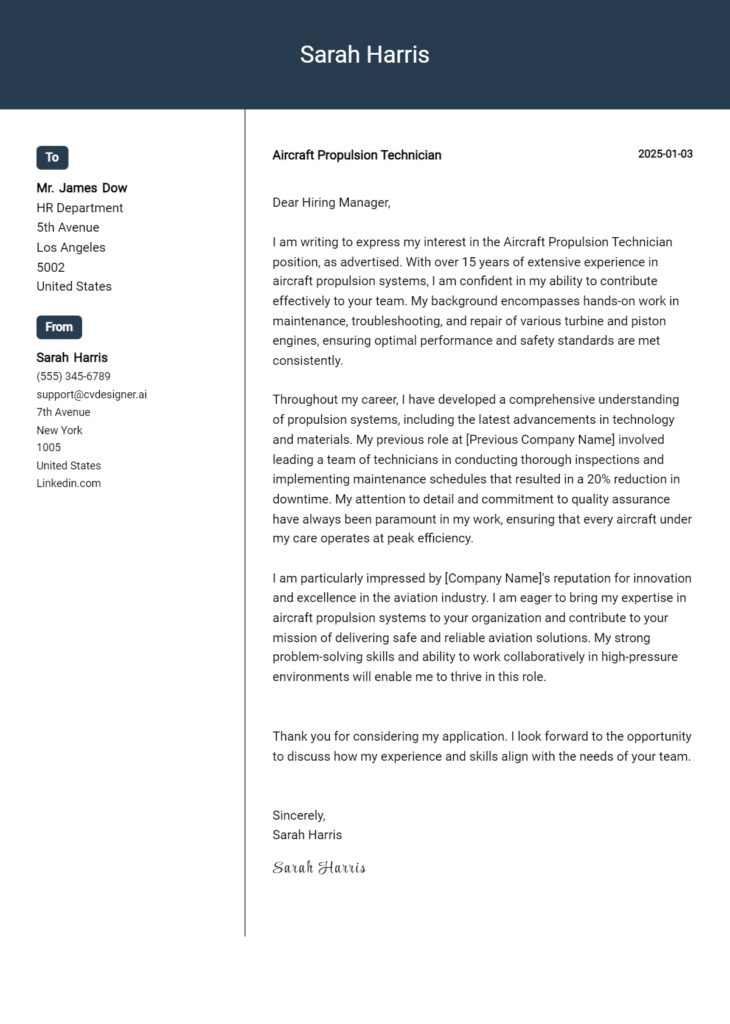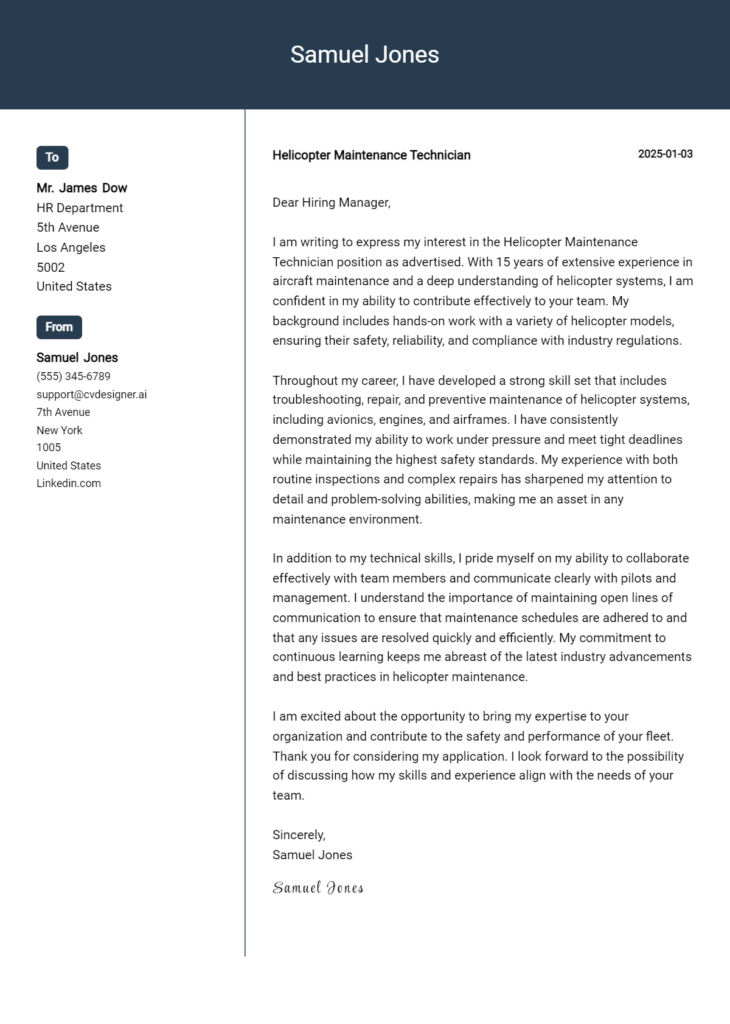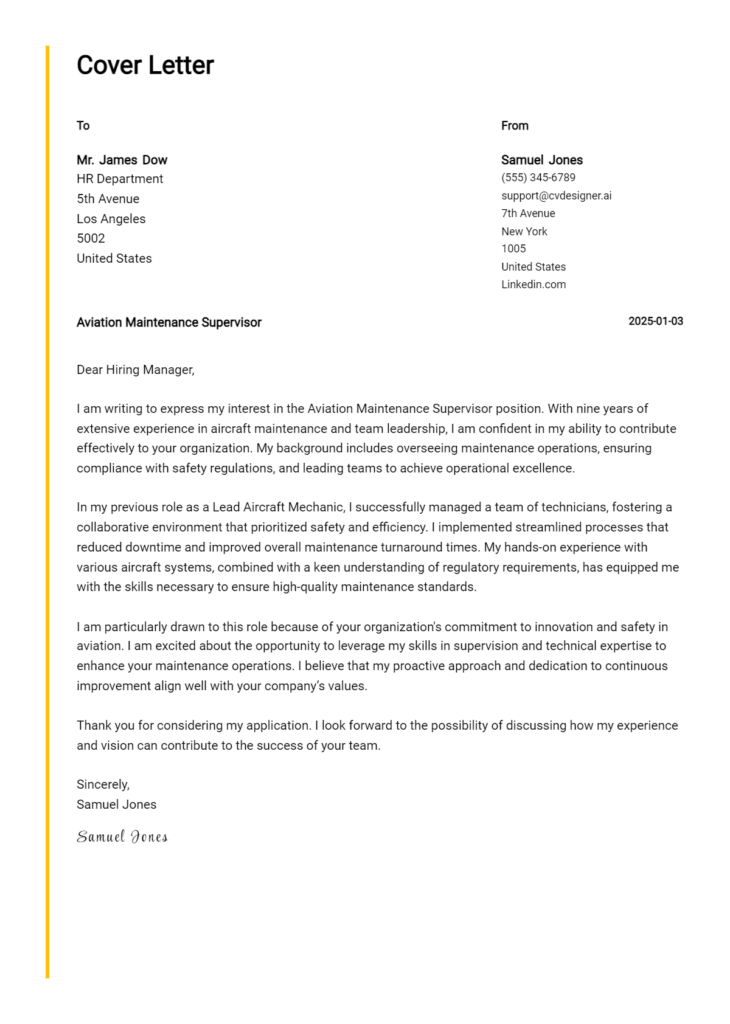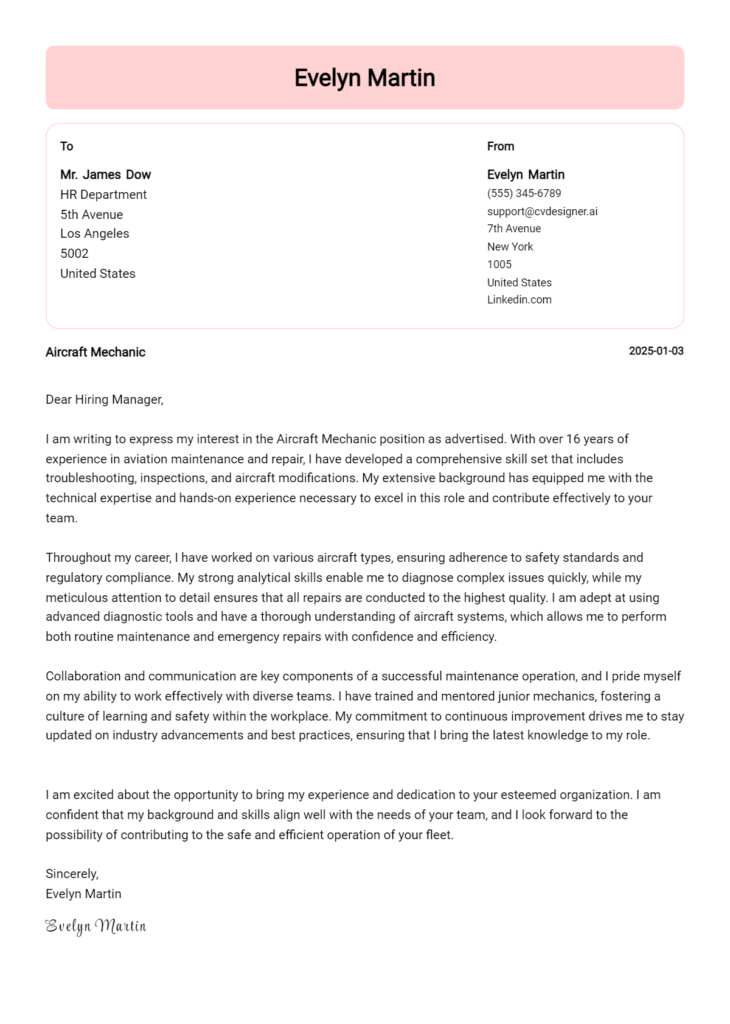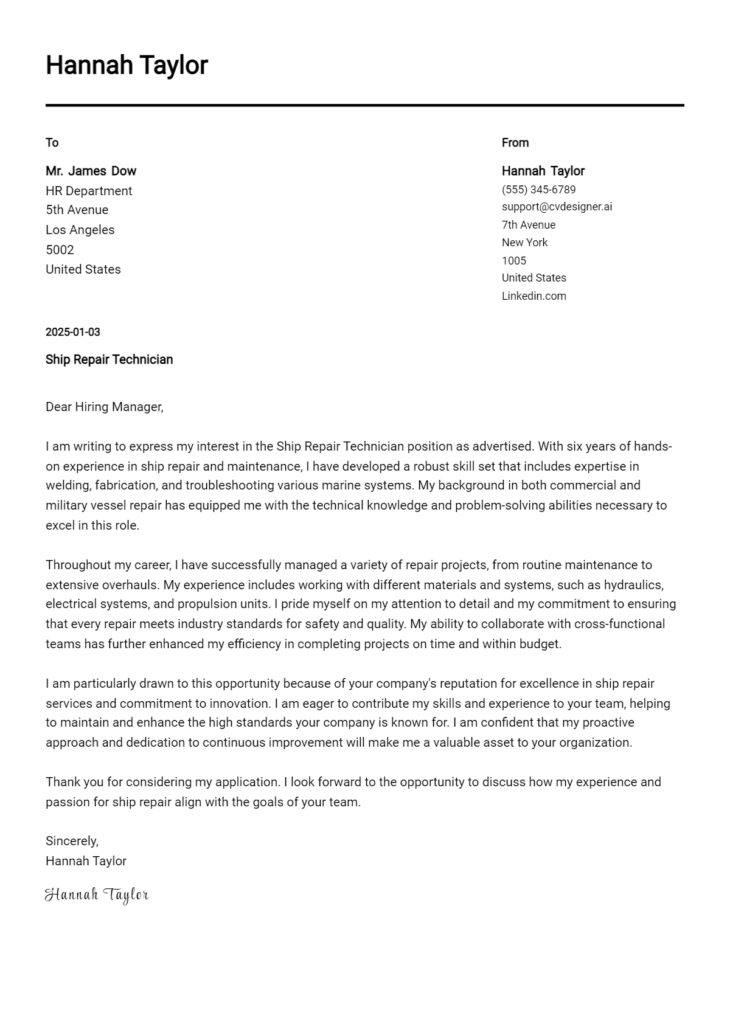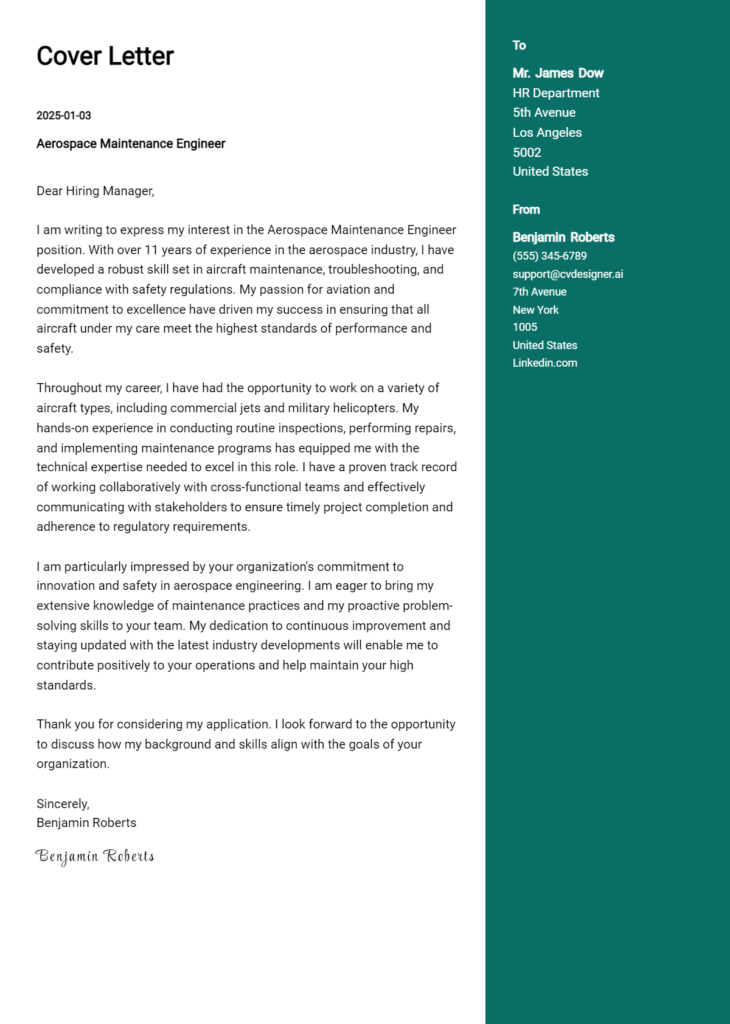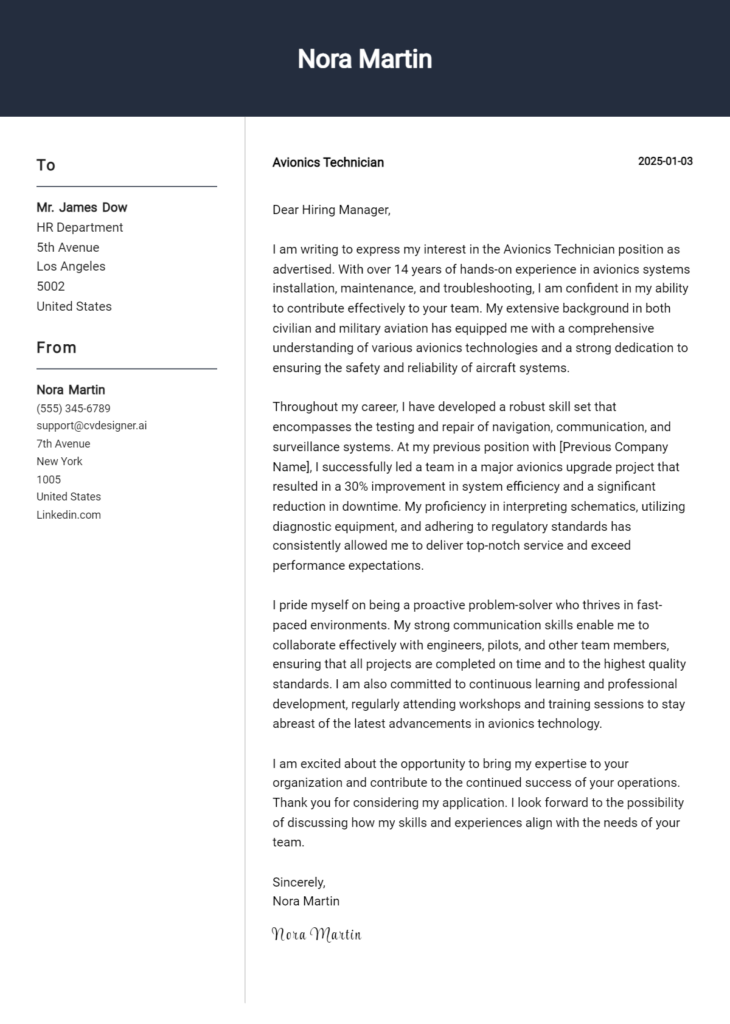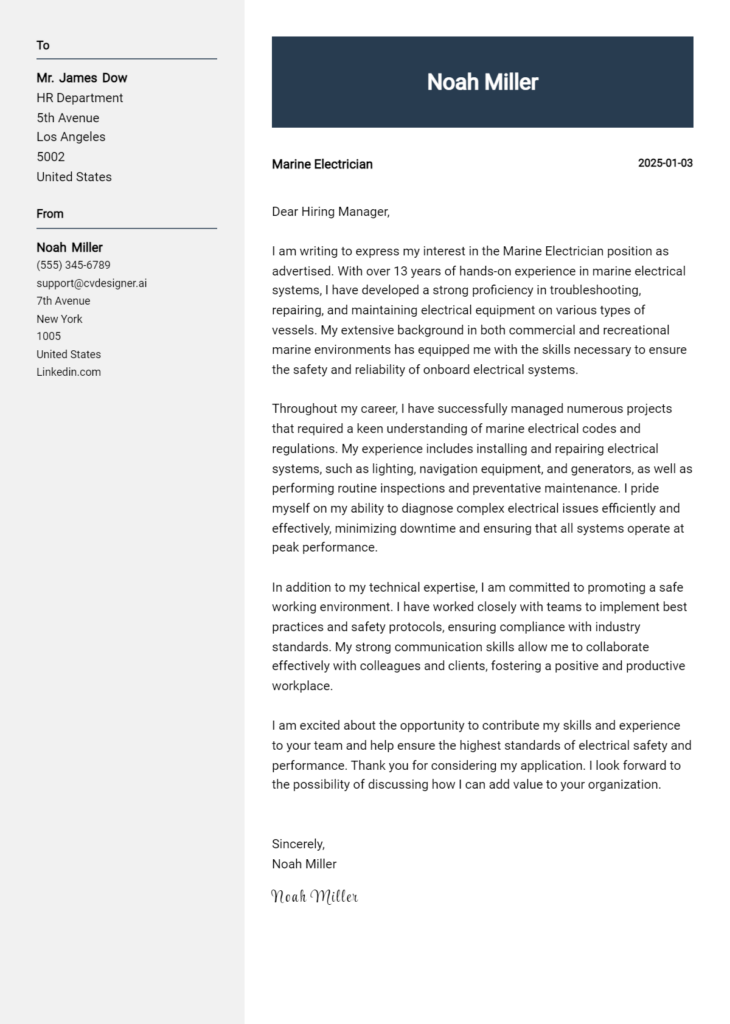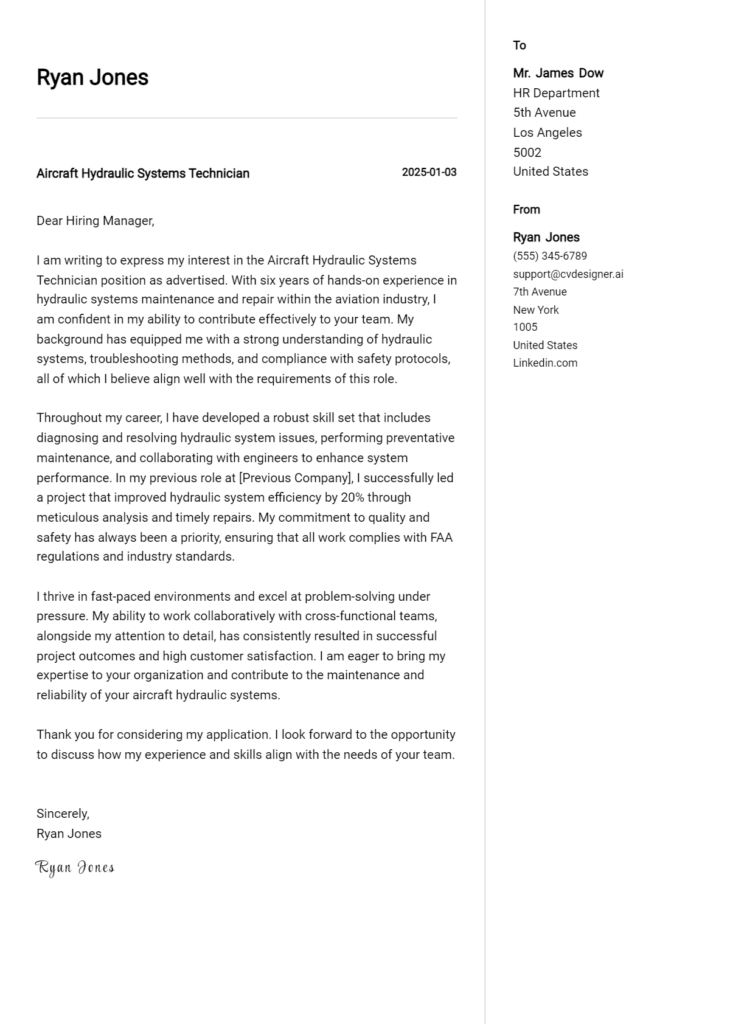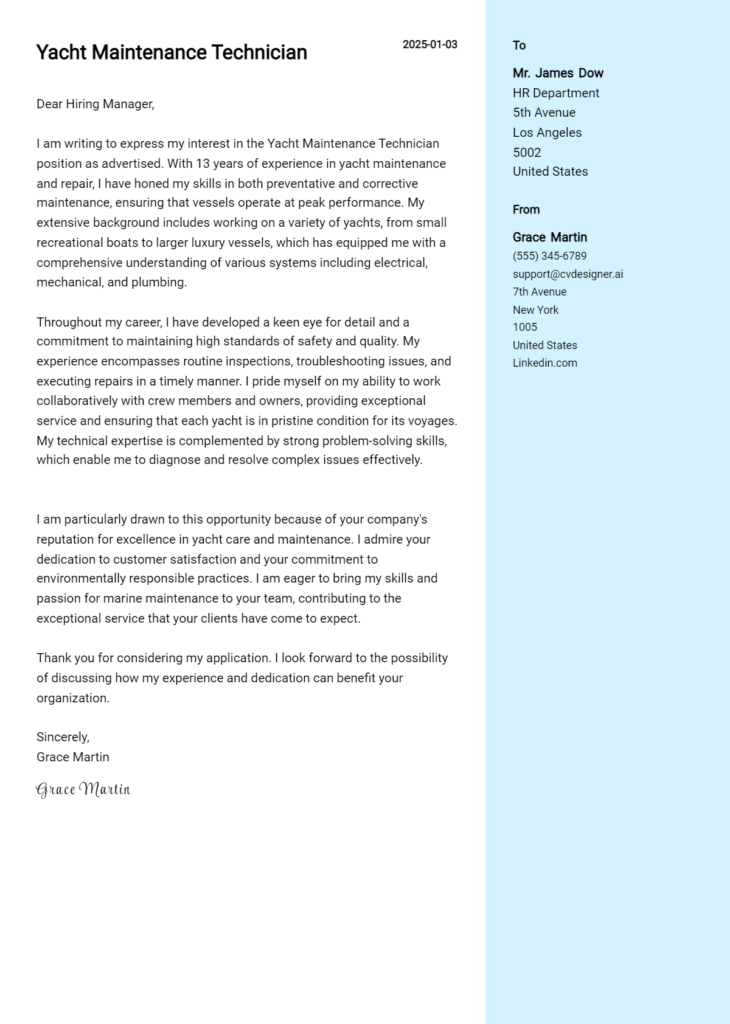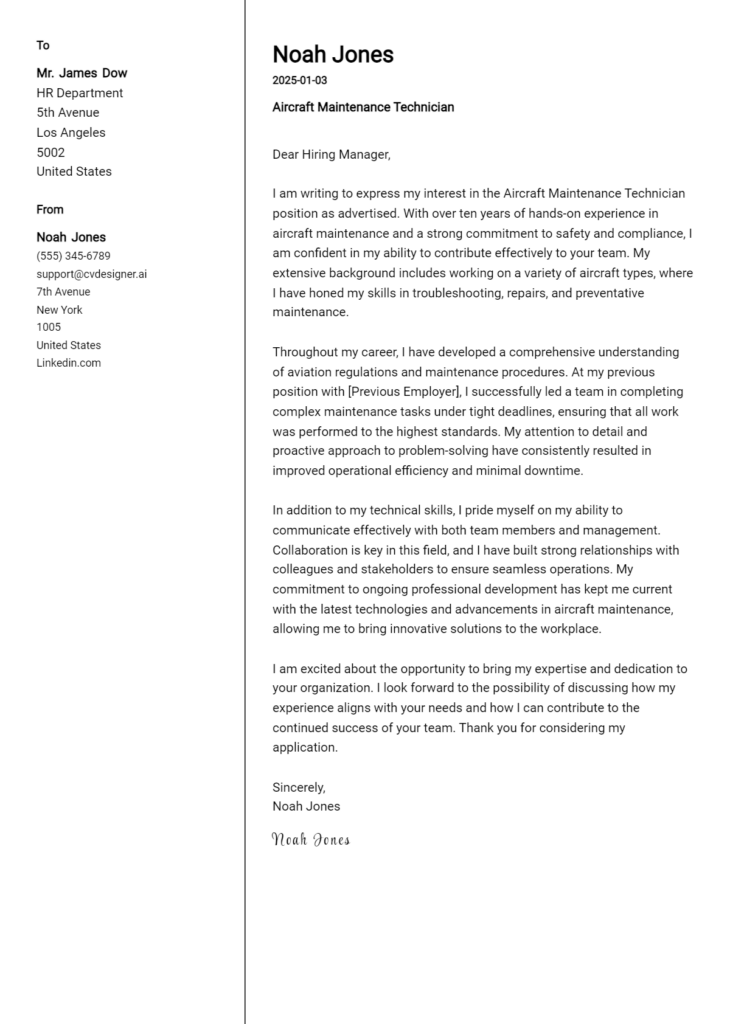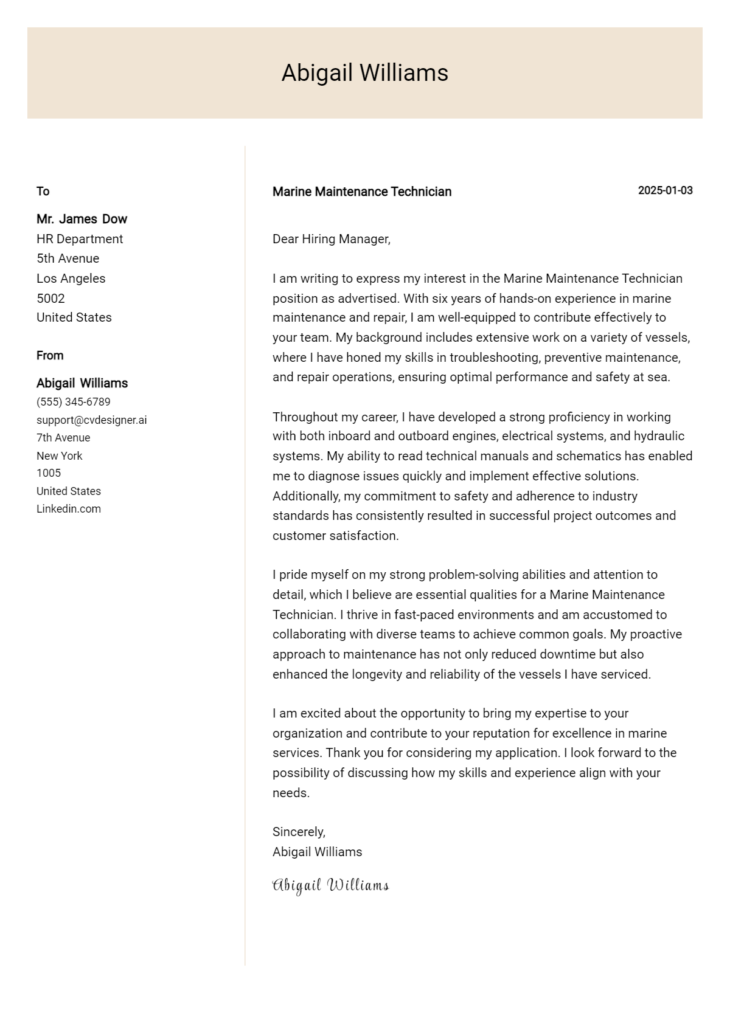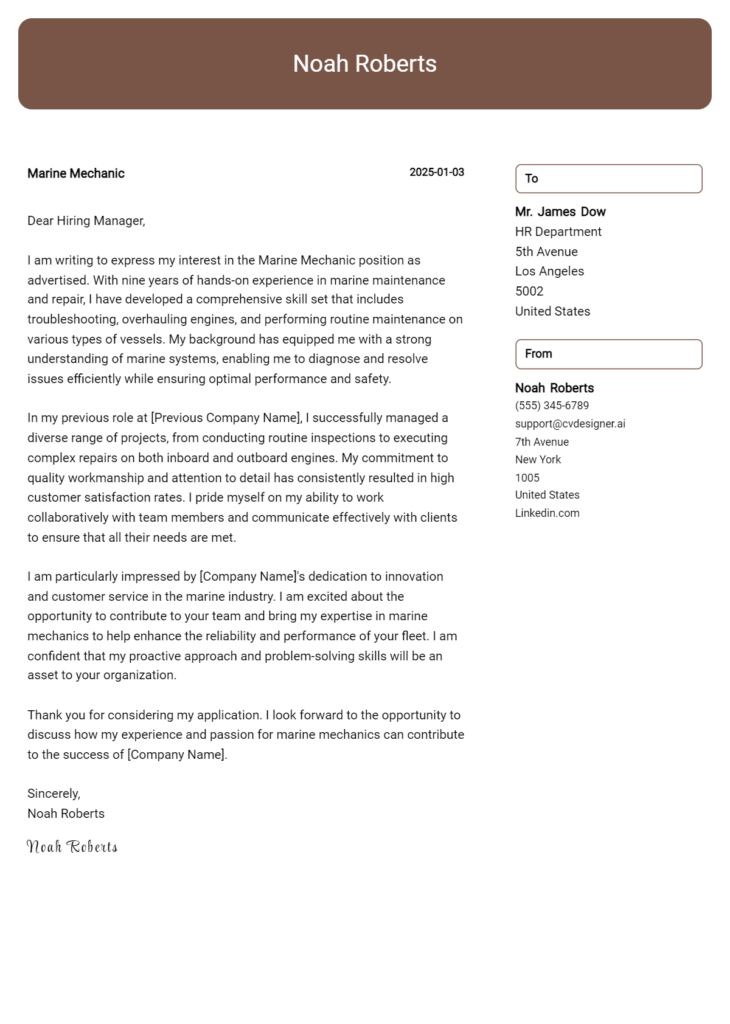Aircraft Electronics Technician Cover Letter Examples
Explore additional Aircraft Electronics Technician cover letter samples and guides and see what works for your level of experience or role.
How to Format an Aircraft Electronics Technician Cover Letter?
Crafting a well-structured cover letter is essential for an Aircraft Electronics Technician, as it serves as your first point of contact with potential employers. The formatting of your cover letter not only showcases your qualifications but also demonstrates your attention to detail and commitment to the aviation industry. A clear and organized presentation can capture the hiring manager's attention and set you apart from other candidates, reflecting the precision and technical expertise vital in aircraft electronics.
In this guide, we will explore the essential components of a professional cover letter, including:
- Cover Letter Header
- Cover Letter Greeting
- Cover Letter Introduction
- Cover Letter Body
- Cover Letter Closing
Each section is crucial for effectively communicating your skills and professionalism. Let’s delve into how to make your cover letter stand out in the competitive field of aircraft electronics.
The Importance of the Cover Letter Header for an Aircraft Electronics Technician
A well-crafted cover letter header is crucial for making a positive first impression on potential employers in the aviation industry. It sets the tone for the rest of the document and provides essential information that allows the recipient to identify and contact you easily. The header should include your contact information, the date, and the recipient's details, all presented in a clear and professional format. This clarity ensures that your cover letter remains organized and easily accessible, which is especially important in a field where precision and attention to detail are paramount.
An effective header can distinguish you from other candidates, while a poorly formatted one might lead to confusion or a lack of professionalism. Below are examples of a strong and weak cover letter header for an Aircraft Electronics Technician:
Strong Example
John Doe 123 Aviation Lane Sky City, ST 12345 (123) 456-7890 john.doe@email.com October 1, 2023 Hiring Manager Aviation Solutions Inc. 456 Flight Path Airfield, ST 67890
Weak Example
john d. 123 ave, city 123-456-7890 10/1/23 manager@company.com
The Importance of a Greeting in Your Cover Letter
The greeting of your cover letter serves as the initial point of contact with the hiring manager and sets the tone for the rest of your correspondence. A well-crafted greeting demonstrates professionalism, shows respect for the recipient, and personalizes your application, making it stand out. By addressing the hiring manager directly, you convey that you have taken the time to research and understand the organization, which can leave a positive impression. To avoid generic greetings like "To Whom It May Concern," it’s advisable to seek out the name of the hiring manager or relevant contact person. This can often be found on the company’s website, LinkedIn, or by calling the company directly.
Strong Greeting Example
Dear Mr. Johnson,
Weak Greeting Example
To Whom It May Concern,
By thoughtfully crafting your greeting, you lay a solid foundation for your cover letter, showcasing both your interest in the position and your commitment to professionalism.
Cover Letter Introduction for Aircraft Electronics Technician
A well-crafted cover letter introduction is crucial for an Aircraft Electronics Technician as it serves as the first impression to the hiring manager. This introductory paragraph should not only capture the reader's attention but also express genuine interest in the role. Moreover, it should briefly highlight key skills or significant achievements that align with the position, setting the tone for the rest of the letter. A strong introduction can differentiate a candidate from others, while a weak one may fail to make an impact, potentially hindering the chances of progressing to the next stage of the hiring process.
Strong Example
Dear Hiring Manager, As a dedicated Aircraft Electronics Technician with over five years of experience in troubleshooting and maintaining complex avionics systems, I am excited to apply for the position at [Company Name]. My hands-on expertise with advanced electronic equipment, combined with a strong commitment to safety and efficiency, has enabled me to contribute to significant improvements in aircraft performance. I am eager to bring my skills to your esteemed team and ensure the highest standards of aircraft reliability and safety.
Weak Example
To Whom It May Concern, I am writing to apply for the Aircraft Electronics Technician position. I have worked in the aviation industry for some time and have some experience with electronics. I think I could do the job well.
Purpose of the Cover Letter Body for an Aircraft Electronics Technician
The body of the cover letter for an Aircraft Electronics Technician serves as a vital platform to showcase the candidate's technical skills, relevant experiences, and the unique value they bring to the company. It is an opportunity to discuss specific projects or accomplishments that demonstrate proficiency in electronic systems, troubleshooting, and maintenance of aircraft electronics. This section should effectively convey how the candidate’s expertise aligns with the company's needs and mission, ultimately making a compelling case for why they are the right fit for the role.
Strong Example
In my previous role at XYZ Aviation, I successfully led a project to upgrade the avionics systems on a fleet of regional jets. This involved diagnosing existing issues, implementing new electronic components, and conducting rigorous testing to ensure compliance with FAA regulations. As a result of my efforts, we improved the aircraft's operational efficiency by 15% and enhanced safety features, which received commendations from both management and our clients. My hands-on experience with advanced electronic systems, combined with my meticulous attention to detail, positions me to contribute effectively to your team at ABC Airlines.
Weak Example
I have worked on aircraft electronics for a couple of years and know a bit about troubleshooting. I think I can be a good fit for your company because I have done some repair work. I hope to work with you and learn more about aircraft electronics.
Importance of the Cover Letter Closing for an Aircraft Electronics Technician
The closing of a cover letter is crucial as it serves to summarize your qualifications, reiterate your enthusiasm for the Aircraft Electronics Technician position, and encourage the hiring manager to take the next steps, such as reviewing your resume or scheduling an interview. A strong closing can leave a lasting impression and reinforce your fit for the role, while a weak closing may diminish your chances of being considered.
Strong Example
Thank you for considering my application for the Aircraft Electronics Technician position. With my extensive experience in aviation electronics and my commitment to ensuring safety and efficiency, I am eager to bring my skills to your esteemed team. I look forward to the opportunity to discuss how I can contribute to your organization. Please feel free to review my resume, and I hope to schedule an interview soon.
Weak Example
I hope you like my cover letter. I think I could do the job. Please look at my resume if you have time.
Crafting a compelling cover letter is essential for candidates seeking a position as an Aircraft Electronics Technician. This document not only introduces you to potential employers but also serves as a platform to showcase your technical skills, problem-solving abilities, knowledge of the Software Development Life Cycle (SDLC), teamwork experience, and passion for continuous learning. Here are some tips to help you create an effective cover letter that stands out.
Tips for Writing an Effective Cover Letter
Highlight Your Technical Skills
Tailor your cover letter to emphasize your specific technical skills relevant to aircraft electronics. Mention your proficiency in troubleshooting electronic systems, understanding of avionics, and experience with maintenance procedures. Providing examples of your hands-on experience will help illustrate your expertise.Demonstrate Problem-Solving Abilities
Employers value technicians who can address challenges effectively. Include instances where you've successfully diagnosed and resolved complex issues in aircraft electronic systems. Use metrics or outcomes to quantify your achievements, which can significantly enhance your credibility.Showcase Your SDLC Knowledge
If you have experience with software development processes, be sure to mention it. Discuss how your understanding of the SDLC can contribute to improving aircraft systems' reliability and efficiency. This shows that you are not only technically skilled but also knowledgeable about the broader context of your work.Emphasize Teamwork and Collaboration
Aircraft maintenance often involves working with a team. Highlight your experience collaborating with engineers, pilots, and other technicians. Provide examples of how your teamwork led to successful project completions or improved operational efficiency.Express a Passion for Continuous Learning
The aviation industry is always evolving, and employers appreciate candidates who are committed to staying current. Mention any relevant certifications, training programs, or workshops you've attended. Express your enthusiasm for ongoing education and how it can benefit the company.
By implementing these tips, you can create a strong cover letter that effectively communicates your qualifications for the Aircraft Electronics Technician position. If you're looking for inspiration or templates, check out these cover letter templates or consider using a cover letter builder to streamline the process.
Common Mistakes to Avoid in a Aircraft Electronics Technician Cover Letter
Avoiding common mistakes in your cover letter is crucial for standing out in the competitive field of aircraft electronics. A well-crafted cover letter not only showcases your skills but also reflects your professionalism. Here are some common pitfalls to avoid:
Generic Opening: Starting with a vague greeting can make your letter feel impersonal. Always address the hiring manager by name if possible.
Lack of Specificity: Failing to mention specific skills related to aircraft electronics can weaken your application. Tailor your letter to highlight relevant experiences, such as troubleshooting avionics systems.
Too Much Technical Jargon: While technical terms are important, overloading your cover letter with jargon can alienate the reader. Aim for clarity and balance between technical language and readability.
Neglecting the Employer's Needs: Focusing solely on your qualifications without addressing how you can meet the employer’s needs can be a missed opportunity. Research the company and align your skills with their requirements.
Ignoring Formatting Guidelines: Poor formatting can detract from your message. Adhere to standard cover letter format for a professional appearance.
Typos and Grammatical Errors: Errors can undermine your credibility. Proofread your letter multiple times or ask someone else to review it.
Failing to Include a Call to Action: Not closing with a strong call to action can leave the reader without a clear next step. Express your eagerness to discuss your application further.
For inspiration, check out various cover letter examples that can guide you in crafting an effective letter tailored to the aircraft electronics technician role.
Cover Letter FAQs for Aircraft Electronics Technician
How should I start my cover letter for an Aircraft Electronics Technician position?
Starting your cover letter effectively is crucial to grabbing the employer's attention. Begin with a professional greeting, addressing the hiring manager by name if possible. If you don’t have a name, “Dear Hiring Manager” is acceptable. Follow this with a strong opening sentence that briefly states the position you are applying for and your enthusiasm for the role. For example, “I am excited to apply for the Aircraft Electronics Technician position at [Company Name] as advertised on [where you found the job listing].” This approach sets a positive tone and immediately informs the reader of your intent.
What skills should I highlight in my cover letter?
As an Aircraft Electronics Technician, it’s essential to emphasize both technical and soft skills. Highlight your proficiency in troubleshooting and repairing avionics systems, as well as your familiarity with industry regulations and safety standards. Mention specific technical skills like circuit analysis, soldering techniques, or experience with diagnostic equipment. Additionally, don’t overlook soft skills such as attention to detail, problem-solving abilities, and effective communication. Providing examples from your experience can strengthen your claims and demonstrate your hands-on expertise in the field.
Should I include specific achievements in my cover letter?
Absolutely! Including specific achievements in your cover letter can set you apart from other candidates. Quantify your accomplishments whenever possible to provide tangible evidence of your skills. For instance, mention if you successfully reduced repair times by a certain percentage or led a project that enhanced the functionality of avionics systems. You might say, “During my previous role at [Previous Company], I implemented a new diagnostic procedure that decreased troubleshooting time by 20%, enhancing overall operational efficiency.” Specific achievements not only showcase your capabilities but also demonstrate your commitment to making a positive impact in your next role.
How long should my cover letter be?
Your cover letter should ideally be one page long, concisely summarizing your qualifications and interest in the Aircraft Electronics Technician position. Aim for about three to four paragraphs, focusing on your relevant skills, experiences, and what you can bring to the company. Keep it succinct and to the point—recruiters often have limited time to read applications. A well-structured cover letter that is clear and engaging will make a stronger impression than a longer, unfocused one. Remember to proofread for any errors to ensure professionalism.
Build your Cover Letter in minutes
Use an AI-powered cover letter builder and have your letter done in 5 minutes. Just select your template and our software will guide you through the process.

